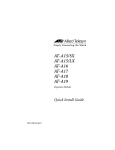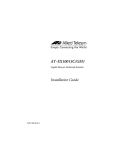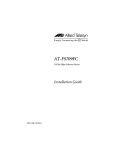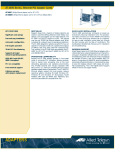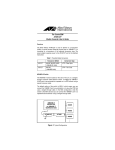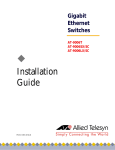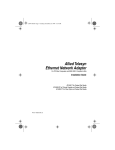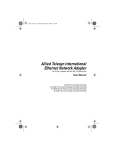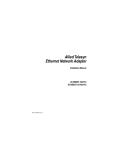Download Allied Telesis AT-2450 Series Instruction manual
Transcript
This product complies with FCC Part 15B, Class B Limits: This device complies with part 15 of the FCC Rules. Operation is subject to the following two conditions: (1) This device must not cause harmful interference, and (2) this device must accept any interference received, including interference that may cause und esired operation. This equipment has been tested and found to comply with the limits for a Class B digital device, pursuant to Part 15 of the FCC rules. These limits are designed to provide reasonable protection against harmful interference in a residential installation. This equipment generates, uses and can radiate radio frequency energy and, if not installed and used in accordance with instructions, may cause harmful interference to radio or television reception, which can be determined by turning the equipment off and on. The user is encouraged to try to correct the interference by one or more of the following measures: - Reorient or relocate the receiving antenna. - Increase the separation between the equipment and the receiver. - Connect the equipment into an outlet on a circuit different from that to which the receiver is connected. - Consult the dealer or an experienced radio/TV technician for help. Changes and modifications not expressly approved by the manufacturer or registrant of this equipment can void your authority to operate this equipment under Federal Communications Commission rules. RADIATED ENERGY U.s. Federal Communications Note: This equipment has been tested and found to comply with the limits for a Class A digital device pursuant to Part 15 of FCCRules. These limits are designed to provide reasonable protection against harmful interference when the equipment is operated in a commercial environment. This equipment generates, uses, and can radiate radio frequency energy and, if not installed and used in accordance with this instruction manual, may cause harmful interference to radio communications. Operation of this equipment in a residential area is likely to cause harmful interference in which case the user will be required to correct the interference at his own expense. Note: Modifications or changes not expressly approved of by the manufacturer or the FCC, can void your right to operate this equipment. Industry Canada This Class B digital apparatus meets all requirements of the Canadian Interference-Causing Equipment Regulations. Cet appareil numérique de la classe B respecte toutes les exigences du Règlement sur le matériel brouilleur du Canada. RFI Emission EN55022 Class B Immunity EN50082-1 SAFETY Electrical Safety TUV-EN60950, UL1950, CSA 950 Laser EN60825 This is a “CLASS 1 LED PRODUCT” Warning Do not stare into the Laser beam. EN55022 Klasse B EN50082-1 TUV-EN60950, UL1950, CSA 950 EN60825 Dette er et “PRODUKT UNDER KLASSE 1 LED” ADVARSEL Stirr ikke på strålen. BETJENINGSTEMPERATUR Dette apparat er konstrueret til en omgivende temperatur på maksimum 50 grader C. ALLE LANDE: Installation af produktet skal ske i overensstemmelse med lokal og national lovgivning for elektriske installationer. EN55022 Clase B EN50082-1 TUV-EN60950, UL1950, CSA 950 EN60825 Este es un “PRODUCTO DE DIODO LUMINISCENTE (LED) CLASE 1” ¡ADVERTENCIA! No mirat fijamente el haz. Operating System TEMPERATURA REQUERIDA PARA LA OPERACIÓN Este producto está diseñado para una temperatura ambiental máxima de 50 grados C. PARA TODOS LOS PAÍSES: Monte el producto de acuerdo con los Códigos Eléctricos locales y nacionales. Radiostörning Immunitet SÄKERHET Elsäkerhet Laser Windows 95 EN55022 Klass B EN50082-1 TUV-EN60950, UL1950, CSA 950 EN60825 Windows NT Detta är en “KLASS 1 LYSDIODPRODUKT” VARNING! Laserstrålning när enheten är öppen. EN55022 Klasse B EN50082-1 Preparing for Installation TUV-EN60950, UL1950, CSA 950 EN60825 These instructions assume the computer operating system is installe according to your computer’s documentation. For the majority of applications, installing the AT-2450 PCI Ethernet Network Adapter Card involves plugging the adapter card into a PCI slot in your computer and installing the driver software. The driver files for the AT-2450 PCI Ethernet Network Adapter Card are found on the AlliedTelesyn CardAssistant diskette, which you will be prompted to insert into the floppy drive. Dit is een “KLASSE 1 LED-PRODUKT” WAARCHUWING Neit in de straal staren. BEDRIJFSTEMPERATUUR De omgevingstemperatuur voor dit produkt mag niet meer bedragen dan 50 graden Celsius. ALLE LANDEN: het toestel installeren overeenkomstig de lokale en nationale elektrische voorschriften. Emission d’interférences radioélectriques Immunité SÉCURITÉ Sécurité électrique Laser TEMPERATURA DE FUNCIONAMENTO Este produto foi projetado para uma temperatura ambiente máxima de 50 graus centígrados. TODOS OS PAÍSES: Instale o produto de acordo com as normas nacionais e locais para instalações elétricas. This guide gives the instructions for installation of a single AT-2450 PCI Ethernet Network Adapter Card in a Microsoft Windows environment. More information is available for other applications of the adapter card. • SETUP24 program—The CardAssistant diskette contains text files with installation and configuration information for each environment. Use the program SETUP24.EXE to find the information you need for your situation. (To view information files, insert the CardAssistant diskette in the floppy drive and type a:\setup24.) If you are using the AT-2450 PCI Ethernet Network Adapter Card in different environment refer to “Advanced Topics” on page 7 of this guide. TUV-EN60950, UL1950, CSA 950 EN60825 BETRIEBSTEMPERATUR Dieses Produkt wurde für den Betrieb in einer Umgebungstemperatur von nicht mehr als or 50° C entworfen. ALLE LÄNDER: Installation muß örtlichen und nationalen elektrischen Vorschriften entsprechen. RFI Emissie Immuniteit VEILIGHEID Electrische Veiligheid Laser Este é um “PRODUTO CLASSE 1 LED” AVISO Não olhe fixamente para o raio. Emisión RFI Inmunidad SEGURIDAD Seguridad eléctrica Laser EN55022 Classe B EN50082 - 1 TUV-EN60950, UL1950, CSA 950 EN60825 Ce matériel est un “PRODUIT À DIODE ÉLECTROLUMINESCENTE DE CLASSE 1” ATTENTION Ne pas fixer le faisceau des yeux. Install the Adapter Card TEMPÉRATURE DE FONCTIONNEMENT Ce matériel est capable de tolérer une température ambiante maximum de 50 degrés Celsius. POUR TOUS PAYS : Installer le matériel conformément aux normes électriques nationales et locales. Warning—High voltages inside the computer present a safety hazard. Make sure the power is off before removing the cover. This LAN adapter card is for use only with IBM or compatible UL-listed personal computers that have installation instructions detailing installation of adapter card-cage accessories. Installation should be performed with precautions to prevent damage to static-sensitive components. Follow your computer’s instruction manual for specific information on installing peripheral devices in your computer. Once the adapter card is seated in a PCI slot and the computer’s cover is back on, plug in the cable, turn on the power, and reboot into Windows. Radioaaltojen häirintä Kestävyys TURVALLISUUS Sähköturvallisuus Laser EN55022 Luokka B EN50082-1 TUV-EN60950, UL1950, CSA 950 EN60825 Tämä on “ENSIMMÄISEN LUOKAN VALODIODITUOTE” VARIOTUS Älä katso säteeseen. KÄYTTÖLÄMPÖTILA Tämä tuote on suunniteltu ympäröivän ilman maksimilämpötilalle 50 °C. KAIKKI MAAT: Asenna tuote paikallisten ja kansallisten sähköturvallisuusmääräysten mukaisesti. Emissione RFI (interferenza di radiofrequenza) Immunità NORME DI SICUREZZA Sicurezza elettrica Laser EN55022 Classe B EN50082-1 TUV-EN60950, UL1950, CSA 950 EN60825 Important cable considerations: AT-2450F Questo è un “PRODOTTO CON LED DI CLASSE 1” AVERTENZA Non fissare il raggio con gli occhi. The cable must comply with the appropriate IEEE 802.3 10BASE-F standard for 62.5/125 µm multi-mode fiber cable. The cable between the computer and the hub must be less than 2000 meters long for full-duple operation and 412 meters long for half-duplex operation. The transmit circuit of the adapter card is connected to the receive circuit of the hub and vice versa. TEMPERATURA DI FUNZIONAMENTO Questo prodotto è concepito per una temperatura ambientale massima di 50 gradi centigradi. TUTTI I PAESI: installare il prodotto in conformità delle vigenti normative elettriche nazionali. RFI stråling Immunitet SIKKERHET Elektrisk sikkerhet Laser EN55022 Klasse B EN50082-1 TUV-EN60950, UL1950, CSA 950 EN60825 Dette er et “KLASSE 1 LED PRODUKT” ADVARSAL Stirr ikke på strålen. DRIFTSTEMPERATUR Dette produktet er konstruert for bruk i maksimum romtemperatur på 50 grader celsius. ALLE LAND: Produktet må installeres i samsvar med de lokale og nasjonale elektriske koder. 2 5. The Allied Telesyn AT-2450 CardAssistant diskette provides drivers for Windows 95, Windows 98, Windows NT and version 3.11 of Windows for Workgroups. If you don’t know your Windows version, open the Microsoft Windows System Control Panel. Under the General tab of the System Properties dialog box, note your System release number. Pick the driver you need from the following table so that you can point Windows to the right directory on the CardAssistant diskette during installation. TUV-EN60950, UL1950, CSA 950 EN60825 Sources of Information EN55022 Klasse B EN50082-1 Das ist ein “LED Produkt der Klasse 1” WARNUNG Nicht direkt in den Strahl blicken. Radiofrekvens forstyrrelsesemission Immunitet SIKKERHED Elektrisk sikkerhed Laser Check your Windows version EN55022 Classe B EN50082-1 DRIFTSTEMPERATUR Denna produkt är konstruerad för rumstemperatur ej överstigande 50 grader Celsius. ALLA LÄNDE : Installera produkten i enlighet med lokala och statliga bestämmelser för elektrisk utrustning. OPERATING TEMPERATURE This product is designed for a maximum ambient temperature of 50 degrees C. ALL COUNTRIES: Install product in accordance with local and National Electrical Codes. Hochfrequenzstörung Störsicherheit SICHERHEIT Elektrische Sicherheit Laser Emissão de interferência de radiofrequência Imunidade SEGURANÇA Segurança Eléctrica Laser 3 Release Driver Location 4.00.950, 4.00.950a NDIS3 a:\ndis3 4.00.950b, 4.00.950c NDIS4 a:\ 3.5 or 3.5.1 NDIS3 a:\ndis3 4 or above NDIS4 a:\ Windows 98 All NDIS4 a:\ Windows for Workgroups 3.11 NDIS2 a:\ Install the Drivers Windows 95 or Windows 98 From the Windows version table above, determine whether you need the NDIS3 driver or the NDIS4 driver. Install the AT-2450 PCI Ethernet Network Adapter Card and start Windows. The New Hardware Found dialog box appears, and you are prompted for the driver. Insert the CardAssistant diskette, and direct Windows to the location of the driver: type a:\ for the NDIS4 driver and a:\ndis3 for the NDIS3 driver. Make sure Allied Telesyn AT-2450 PCI Ethernet Network Adapter Card appears in the driver found dialog box. Follow the Windows instructions, supplying Windows files as needed. Windows prompts you to restart the computer. You are ready to access your network. Windows NT With the AT-2450 PCI Ethernet Network Adapter Card installed and Windows NT started, you are ready to install the driver. 1. Open the add adapter dialog box as follows: NT 4.x—double-click the Network icon in the Control panel. Then select the Adapters tab and click the Add button. NT 3.5x—open the Main program group by double-clicking its icon; then double-click the Control Panel icon, double-click the Network icon, and click Add Adapter from the Network box. 2. Insert the AT-2450 CardAssistant diskette into your floppy drive. Choose install from manufacturer's diskette as follows: NT 4.x—click the Have Disk button in the Select Network Adapter pop-up window. In the text field of the dialog box, type: a:\ and choose OK. NT3.5x—choose <OTHER> REQUIRES DISK from Manufacturer in the Network Adapter Card drop-down list. Then click Continue. In the text field of the dialog box, type: a:\ndis3 and choose OK. 3. Verify that Allied Telesyn AT-2450 PCI Ethernet Network Adapter Card appears in the Select OEM option dialog box and choose OK. 4. In the Network Settings dialog box, verify that Allied Telesyn AT-2450 PCI Ethernet Network Adapter Card appears in the Installed Adapter Cards list. If you wish, you can configure network protocols you will be using for network communications. Select the protocols used on your network, and when you are done, click OK (Close in Windows NT 4.0). 4 From the Network Settings Change dialog box, click Restart Now. After the Windows NT operating system shuts down, restart your computer. This completes the installation.You are ready to access your network. Note—If you’re installing multiple cards on the same computer, see CardAssistant information file for Windows NT. (To view information files, insert the CardAssistant diskette in the diskette drive and typea:\setup24). Windows for Workgroups (WFW) 3.11 With the AT-2450 PCI Ethernet Network Adapter Card installed, start Windows for Workgroups. You are ready to install the driver. 1. From the Network group in Program Manager, choose Network Setup. 2. In the Network Setup dialog box, choose Networks. 3. In the Networks dialog box, verify that Install Microsoft Windows Network is selected. Then choose OK. 4. In the Network Setup dialog box, choose Sharing. 5. In the Sharing dialog box, select whether to allow file and/or printer sharing with other users. 6. In the Network Setup dialog box, choose Drivers. Then, in the Network Drivers dialog box, choose Add Adapte . 7. In the Add Network Adapter dialog box, select Unlisted or Updated Network Adapter. Then choose OK. 8. Insert the AT-2450 CardAssistant diskette into your floppy drive. In the text box of the Install Driver dialog box, type: a:\ and choose OK. 9. In the Network Adapters list of the Unlisted or Updated Network Adapter dialog box, verify that AT-2450 PCI Ethernet Network Adapter Card is highlighted. Then choose OK. 10. In the Network Drivers dialog box, verify that the AT-2450 PCI Ethernet Network Adapter Card and its default protocols, Microsoft NetBEUI and IPX/SPX Compatible Transport with NetBIOS, appear in the Network Drivers list. Then choose Close. 11. In the Network Setup dialog box, choose OK. 12. If prompted, insert the required WFW diskette(s) into your floppy drive and then choose OK. (WFW occasionally loses its place at this point; if you get a message from Windows that it can’t find a file, try inserting WFW install diskettes 7 and 8.) 13. If prompted, reinsert the CardAssistant diskette into your floppy drive. In the text box of the Install Driver dialog box, choose OK. 14. From the Windows Setup dialog box, choose Restart Computer. This completes the installation.You are ready to access your network. The Configuration and Diagnostics Utility: SETUP24 In PCI Ethernet adapter cards, most operating parameters are under PCI-bus control. The Allied Telesyn SETUP24 configuration and diagnostics program allows you to: • View the configuration • Run diagnostic tests on the EEPROM, on adapter card/computer communications, and on network communications • View context-sensitive configuration and diagnostics help • Switch between full- and half-duplex (requires a full-duplex hub; default is half-duplex) or force speed (default is auto detect) • View configuration-information files about many different network operating systems Although not required for operation, it’s a good idea to run diagnostic tests every time you install an adapter; first test the adapter card off the network, then again after attaching it to the network. If you are installing the AT-2450 PCI Ethernet Network Adapter Card in a network operating system not covered in this guide, you also may wish to consult one of the information files available through SETUP24. 5 To launch and run SETUP24: 1. Reboot the computer in DOS with no drivers loaded. (In Windows 9x, boot into the Command prompt only option. Press the F8 key when the message Starting Windows 9x appears, and select Startup Menu choice 6. Command prompt onl .) 2. Insert the CardAssistant diskette in the floppy drive and launch SETUP24; type a:\setup24. 3. The opening screen displays a table of adapter cards installed in your computer. Select the adapter card you wish to view. Select Configuration or Diagnostics or View information from the main menu. (To see a help screen within SETUP24, press the F1 key.) To run the network diagnostics: The CardAssistant Network test is a live send/receive exercise, involving sending packets to a respondent (or more) on the network and counting the responses. You set up at least one computer to act as responder first then set up and start the sender. For each computer: 1. Make sure the cable is connected to the network and you get a valid Link indication. 2. Launch SETUP24, choose an adapter card from the opening screen, and from the main menu select Diagnostics and then select Network test. 3. Press F5 to start the sending machine. The sender counts packets sent and received. The number of packets received should be the number sent times the number of respondents. LED Status Label Function Description TX Transmit Transmitting packets RX Receive Receiving packets LNK Link pulse Link pulse detected on segment Advanced Topics AlliedTelesyn supplies information files on the CardAssistant diskette. If you are installing the adapter card in one of the following situations, you may wish to refer to this additional information for the particular network software you are using. Multiple card installation 3 How to see MAC address 3 Novell server support 3 ODI support 3 UNIX support 3 Removing a driver 3 Files needed for install listed 3 Advanced cabling considerations 3 Sample configuration files 3 PCI bus considerations 3 100 Megabit considerations 3 Full-duplex operation 3 ACPI/Wake on LAN 3 To view SETUP24 topics Insert the CardAssistant diskette in the diskette drive and type: a:\setup24 6 Troubleshooting Tips A networked computer system is a complex combination of hardware and software, all of which must function for data communication to work. Although most problems occur when the adapter card is first being installed or when someone changes something in the network, a problem could be caused by your computer software, by cabling, or by many components elsewhere in the network. The following list offers some general guidelines for troubleshooting the AT-2450 PCI Ethernet Network Adapter Card. 1. Carefully observe the behavior of the system and identify the exact symptoms. Gather information about the system and its components, such as device drivers, memory and extensions (e.g., QEMM), other peripheral adapter cards and the use of I/O ports and IRQs. Record your interaction with the computer, noting the conditions, your actions and the responses. Analyzing this information will help you diagnose the cause of the failure. Experiment with possible solutions. As you experiment, vary only one factor at a time. 2. Substitute known good equipment to see if the problem is eliminated. 3. Don’t overlook the obvious. Make sure the adapter card is seate in the computer and the cables and connectors are securely attached. 4. Check your computer manual for BIOS Setup instructions (sometimes called CMOS Setup). Make sure the PCI slot is enabled. In some mixed ISA/PCI PCs you must make sure the PCI slot has a unique interrupt request (IRQ) number assigned. 5. Check the LNK indicator light. If the LNK indicator does not light, make sure the cabling is intact and connected to a functioning network port, and the network port speed and duplex settings match those of the network adapter card. If the LNK indicator lights but data transfer is slow, collision-prone, or non-existent, verify that your cable is of Category 3, 4, or 5. Category 1 and 2 voice-grade cable will not work properly. If the cable is more or less round in section, you probably have data grade cable, correctly paired, and no transmission problems. If, however, the cable appears flat in cross-section (as Silver Satin telephone-type cable) you probably have voice-grade cable and transmission problems. If it looks like telephone cable, double-check. 6. If you are using EMM386.EXE, verify that you have version 4.49 or higher. Lower versions of EMM386 can cause a PCI machine to lock up or reboot. Version 4.49 ships with DOS 6.22 and is available on the Microsoft forum on CompuServe. 7. If you suspect the network adapter card is not working properly, disconnect the network cable and run CardAssistant diagnostics after rebooting and with no drivers loaded. If CardAssistant software does not detect the adapter card, it could mean a conflict between the adapter card and another device, an adapter card failure, or a slot failure. You may need to reconfigure the other device to avoid the conflict. Try installing the AT-2450 PCI Ethernet Network Adapter Card in another slot, then, if necessary, in another computer. 8. If the adapter card passes diagnostics, try reconnecting the computer to the network. A failure may be caused by physical medium connections or by corrupted network software. You can test the connectors and cables by swapping them for known good ones. Replace corrupted network software. 9. If, after installing and loading the driver, an error message is returned indicating that the device could not be found, and you have verified that the BIOS setup and/or the PCI setup procedure for the slot in use is correct, then re-load the driver with the following switch in the appropriate configuration file for your driver: BUSTYPE = PCI1 7 The exact format of this switch will depend upon the driver in use. For example, for the ODI workstation driver, add this line to the NET.CFG file in the LINK DRIVER section for the AT-2450 card (omit the = sign). For the NDIS 2.0 driver, add this line to the AT-2450 section of the PROTOCOL.INI file. If your computer is supported by a system administrator or network administrator, this person can often provide the most help in resolving a problem. AlliedTelesyn dealers also provide technical support for installation problems. You can contact the dealer where you bought your AT-2450 PCI Ethernet Network Adapter Card for local assistance. Network Adapter Card Technical Support or Service You can contact the dealer where you bought your AT-2450 PCI Ethernet Network Adapter Card for local assistance. If local help is unable to resolve your problem, Allied Telesyn offers technical support via fax or telephone. Refer to the http://www.alliedtelesyn.com website for current world-wide office locations. AT-2450F Series ! Quick Install Guide FOR USE WITH AT-2450F/ST AND AT-2450F/SC PRODUCTS Copyright 1998, 1999 Allied Telesyn International, Corp. 960 Stewart Drive, Suite B, Sunnyvale CA 94086 USA Tel: (408) 730-0950 All rights reserved. No part of this publication may be reproduced without prior written permission from Allied Telesyn International, Corp. Ethernet is a registered trademark of Xerox Corporation. All other product names, company names, logos or other designations mentioned herein are trademarks or registered trademarks of their respective owners. PN 613-10721-00 Rev. A 8



